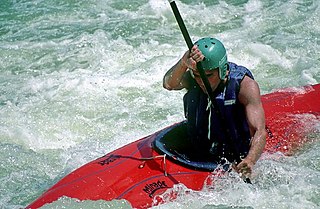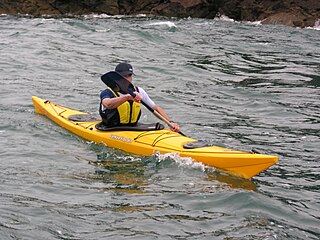
A kayak is a small, narrow human-powered watercraft typically propelled by means of a long, double-bladed paddle. The word kayak originates from the Greenlandic word qajaq.

Kayaking is the use of a kayak for moving over water. It is distinguished from canoeing by the sitting position of the paddler and the number of blades on the paddle. A kayak is a low-to-the-water, canoe-like boat in which the paddler sits facing forward, legs in front, using a double-bladed paddle to pull front-to-back on one side and then the other in rotation. Most kayaks have closed decks, although sit-on-top and inflatable kayaks are growing in popularity as well.

A canoe is a lightweight narrow water vessel, typically pointed at both ends and open on top, propelled by one or more seated or kneeling paddlers facing the direction of travel and using paddles. In British English, the term canoe can also refer to a kayak, while canoes are then called Canadian or open canoes to distinguish them from kayaks. However, for official competition purposes, the American distinction between a kayak and a canoe is almost always adopted.

Canoeing is an activity which involves paddling a canoe with a single-bladed paddle. Common meanings of the term are limited to when the canoeing is the central purpose of the activity. Broader meanings include when it is combined with other activities such as canoe camping, or where canoeing is merely a transportation method used to accomplish other activities. Most present-day canoeing is done as or as a part of a sport or recreational activity. In some parts of Europe canoeing refers to both canoeing and kayaking, with a canoe being called an open canoe.

A sea kayak or touring kayak is a kayak used for the sport of paddling on open waters of lakes, bays, and oceans. Sea kayaks are seaworthy small boats with a covered deck and the ability to incorporate a spray deck. They trade off the manoeuvrability of whitewater kayaks for higher cruising speed, cargo capacity, ease of straight-line paddling (tracking), and comfort for long journeys.

Whitewater kayaking is an adventure sport where a river is navigated in a decked kayak. Whitewater kayaking includes several styles. River running; where the paddler follows a river and paddles rapids as they travel. Creeking usually involving smaller, steeper, and more technical waterways. Creek boats tend to be short but high volume to allow for manoeuvrability while maintaining buoyancy. Slalom requires paddlers to navigate through "gates". Slalom is the only whitewater event to be in the Olympics. Play boating involves staying on one feature of the river and is more artistic than the others. Squirt boating uses low-volume boats to perform special moves in whitewater features.

Wildwater canoeing is a competitive discipline of canoeing in which kayaks or canoes are used to negotiate a stretch of river speedily. It is also called "Whitewater racing" or "Downriver racing" to distinguish it from whitewater slalom racing and whitewater rodeo or Freestyle competition.

Canoe slalom is a competitive sport with the aim to navigate a decked canoe or kayak through a course of hanging downstream or upstream gates on river rapids in the fastest time possible. It is one of the two kayak and canoeing disciplines at the Summer Olympics, and is referred to by the International Olympic Committee (IOC) as Canoe/Kayak Slalom. The other Olympic canoeing discipline is canoe sprint. Wildwater canoeing is a non-Olympic paddlesport.

Canoe sprint is a water sport in which athletes race in specially designed canoes or kayaks on calm water over a short distance. The sport is governed over by the International Canoe Federation and it is one of the two kayaking and canoeing disciplines at the Summer Olympics. The other Olympic canoeing discipline is canoe slalom.

The Waveski, previously known as the "Paddle Ski” is a surfboard where the rider 'sits' on top of the surfboard. Waveski surfing is a dynamic sport combining paddle power with the manoeuvrability and performance of a surfboard. A Waveski resembles a larger volume surfboard, with the addition of a hollowed out seat with seat belt, foot straps and double ended paddle enabling the rider to remain attached to the board for maneuvers and to 'Eskimo roll' if overturned. The waveski rider or surfer uses a double-ended paddle while seated. To turn the rider uses his weight to lean on the side rails and paddle to pivot or propel the board up the wave. The sport is categorized under the International Canoe Federation. The discipline holds biennial World championship events, the next of which will be held at the Nahoon Reef, outside the town of East London, South Africa.

A surfski is a type of kayak in the kayaking "family" of paddling craft. It is generally the longest of all kayaks and is a performance oriented kayak designed for speed on open water, most commonly the ocean, although it is well suited to all bodies of water and recreational paddling.

A sprint canoe is a canoe used in International Canoe Federation canoe sprint. It is an open boat propelled by one, two or four paddlers from a kneeling position, using single-bladed paddles. The difficulty of balance can depend on how wide or narrow the canoe is, although regularly the less contact a canoe has with the water the faster it goes. This makes the narrower boats much faster and popular when it comes to racing.
The ICF Canoe Sprint World Championships are an international event in canoe racing, one of two Summer Olympic sport events organized by the International Canoe Federation. The World Championships have taken place every non-Olympic year since 1970 and officially included paracanoe events since 2010; since 2012, paracanoe-specific editions of this event have been held in Summer Paralympic years.

Canoe marathon is a paddling sport in which athletes paddle a kayak or canoe over a long distance to the finish line. The International Canoe Federation states the standard distances are at least 10 kilometres (6.2 mi) without an upper limit, while short distance races are between 3.4 kilometres (2.1 mi), and 10 kilometres (6.2 mi). Many events are raced down sections of river, including currents or portages around obstacles. Some events attract thousands of competitors and are staged over several days.

Canoeing – recreational boating activity or paddle sport in which you kneel or sit facing forward in an open or closed-decked canoe, and propel yourself with a single-bladed paddle, under your own power.

The women's K-1 200 metres sprint canoeing event at the 2020 Summer Olympics took place on 2 and 3 August 2021 at the Sea Forest Waterway. At least 12 canoeists from at least 12 nations competed.

The women's K-1 500 metres sprint canoeing event at the 2020 Summer Olympics took place on 4 and 5 August 2021 at the Sea Forest Waterway. At least 13 canoeists from at least 13 nations competed.

The men's K-1 1000 metres sprint canoeing event at the 2020 Summer Olympics took place on 2 and 3 August 2021 at the Sea Forest Waterway. At least 15 canoeists from at least 15 nations competed.

The women's K-2 500 metres sprint canoeing event at the 2020 Summer Olympics took place on 2 and 3 August 2021 at the Sea Forest Waterway. At least 20 canoeists from at least 9 nations competed.

The women's K-4 500 metres sprint canoeing event at the 2020 Summer Olympics took place on 6 and 7 August 2021 at the Sea Forest Waterway. 48 canoeists from 10 nations competed.















